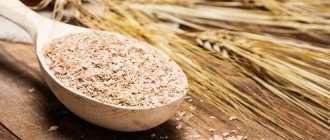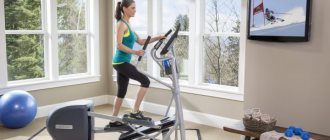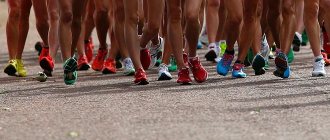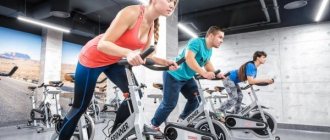Expert – doctor of physical therapy and sports medicine at the multidisciplinary treatment and rehabilitation center Lada Letunovskaya.
Let's consider the most physiological movements for humans: walking and running. Each of them has its own advantages and disadvantages. When choosing one or the other, you should take into account your level of physical fitness, body characteristics, the presence of any diseases, weight and age. If you haven’t actively trained before and have just decided to take care of your own health or start losing weight, walking is more suitable for you. While walking, there is no shock load on the joints, spine, heart and lungs, as when running. There are no contraindications for walking. Now I’m not talking about walking as a sport where trained athletes can reach speeds of up to 10–12 km/h.
Let's try to figure it out point by point.
Load on joints and spine
For an overweight person, walking is much preferable to running, since excess weight in itself places a large load on the spine and joints. During running, there is a so-called flight phase with both legs lifting off the ground at the same time and a landing phase - the moment of transferring the weight of the entire body to one supporting leg. But modern technology allows even overweight people to start running. There are special anti-gravity treadmills for this purpose. They are designed in such a way that the entire lower half of the body is in an enclosed compartment, where, using differential air pressure technology, body weight can be adjusted between 100 and 20%, thereby reducing the stress on the joints and allowing the muscles to work as during normal running. For example, a person weighing 100 kg can run on this treadmill as a person weighing 50 kg on a regular treadmill.
Is sport harmful? To whom and why physical activity is contraindicated Read more
What is more effective: running or walking for weight loss
It all depends on the degree of physical activity, weight and age of the person. As described above, when running, the effect of flight occurs. All the weight falls on one leg, which is very traumatic if you are overweight. The spine works like a spring.
In flight it stretches, and when landing it sharply contracts. If a person is aged, then the spine is already subject to various changes. Plus, with a lot of weight, the load on the spinal discs is very large. At the same time, after running for 2-3 years, you can get a new disease of the legs or spine. Therefore, if you are overweight and over 18, then it is better to go for walks.
If during running the pulse exceeds a certain mark, the fat-burning effect stops. To do this, you need to calculate the maximum heart rate during training and subtract the total number of years. It is easier to control your heart rate while walking. If there is no shortness of breath during exercise, and you can talk freely, then this is the best pace for burning fat.
Impact on stress
Everyone knows that in a stressful situation, playing sports helps relieve tension, relax, and calm down. Runners have a humorous answer to the phrase: “You can’t run away from problems.” - “You will run away, but not before the ninth kilometer.” Indeed, running is a great way to disconnect from negative thoughts, grievances and troubles. As they say, reboot. Walking promotes more leisurely comprehension, balanced making of the right decision and a calm look at the current situation from the outside.
The benefits of running
Running is one of the most accessible ways of physical activity.
It has a lot of advantages:
- Strengthens the heart muscle, respiratory organs and leg muscles. As a result, blood circulation and oxygen supply to organs improves;
- Trains endurance and willpower;
- Helps cleanse the body of toxins that come out with sweat;
- Helps to lose weight;
- Helps cope with depression, because during running the hormone of happiness, joy and pleasure - dopamine - is released. It controls our secret desires and influences libido;
- Has a beneficial effect on the immune and nervous system;
- Running in the fresh air strengthens you.
The disadvantage of running is that it is contraindicated for people with serious chronic diseases.
Muscle strengthening
During running and walking, a large number of different muscle groups are strengthened. During training, the leg muscles are included in the work: the gluteal muscles, the muscles of the front and back of the thigh, the muscles of the lower leg and foot, as well as the muscles of the torso - the iliopsoas, pelvic floor, abs, intercostal and diaphragm, shoulders and back. The inclusion of certain muscle groups depends on the intensity of the activity and the technique of walking or running.
Learning Nordic walking. Master class from a doctor and trainer Read more
What is the fundamental difference
To understand what will be more effective, you need to understand the differences between these two exercises.
The main points that make up the difference between walking and running are:
- when running for more than a quarter of an hour, the body uses all the sugar that “floats” in the bloodstream, fat burning processes begin to work;
- while jogging, a person seems to be flying for a split second, which is impossible when walking; since running also involves jumping, a heavy load is placed on the cartilage tissue;
- if a person is in a state of chronic stress, then only while running - the load is quite high - can he get psychological relaxation, and when walking the effect on stress is disproportionately less;
- when walking, many muscle groups are involved: gluteal, lower legs, shoulder bundles;
- The heart rate will be much lower if a person chooses to walk, a chill behind the sternum is felt quite rarely, so you can exercise much longer than running;
- if you choose running, you need to monitor your heart rate - it should not exceed 120–140 beats per minute for a person aged 40; with this range, fatty tissue is burned most efficiently and in a shorter period of time.
Fat burning rate
Running definitely burns calories faster and more intensely. If you have no contraindications or restrictions, you are physically fit enough and regularly exercise, then you should choose various jogging options to lose weight. If you prefer walking, remember that walking with periodic changes in speed is more effective, that is, alternating a slower pace with a period of acceleration. With this training regimen, calories are burned faster.
Article on the topic
It's all about the sticks. What are the benefits of Nordic walking?
Walking therapy
European doctors prescribed health-improving walking to patients with various diseases back in the early 19th century. They prescribed regular walks along the seashore, along the hills and mountains.
The advantage of walking therapy is that it can be done in any area and at any time of the year. And you don’t need exercise equipment or additional equipment for this. It is enough to have a pair of comfortable shoes.
Benefits of healthy walking
Walking is the best option for overweight people or for those who have just decided to take up exercise. A person can independently control the load, set the desired speed and distance.
Walking therapy can be combined with walks in nature, going to the store or to work.
If the body is weakened after an illness, it is recommended to start classes with a preparatory type of health walking. It must be performed at a slow pace - 60 - 80 steps per minute. At the same time, monitor your pulse and breathing rates.
Gradually, the intensity of movements must be increased and after some time you can switch to the main type of therapeutic walking. Its essence lies in alternating fast (more than 100 steps per minute) and slow walking. At the beginning of the movement, the speed should be comfortable, breathing should not be interrupted. Walk at a slow pace for 5 - 10 minutes, then go to a fast pace for 3 - 5 minutes, after that - again to a slow one.
Before starting class, you need to warm up for 10–15 minutes. The lesson should last 30 – 40 minutes. Finally, there is a stage of slow walking, muscle stretching, breathing and relaxation exercises.
During healthy walking, calories are calculated depending on body weight and speed of movement. At an average walking pace:
- 4 km/hour approximately consumes 3.2 kcal for each kg of weight;
- 6 km/hour – 4.5 kcal;
- 8 km/hour – 10 kcal per 1 kg of weight.
Those who are unable to determine the distance traveled can calculate energy expenditure based on the number of steps per minute:
- 50 steps is approximately 3 km/hour;
- 66 – 4 km/hour;
- 83 – 5 km/hour;
- 100 – 6 km/hour.
To calculate energy costs, you can use fitness bracelets, trackers and software in mobile phones.
In order to accurately calculate calorie consumption, you need to enter your weight, gender, age, and walking speed.
The energy consumption of the body is increased by weights, more difficult routes, and additional exercises while walking.
Training duration and nutrition
Regardless of whether you prefer to run or walk, you should set aside at least an hour for your workout. In the first half hour of training, glycogen reserves are burned, and only then the active process of fat burning begins. You should eat at least one and a half to two hours before the start of your workout. In addition, you should remember: if you want to lose weight, then you should refrain from eating for at least 1.5 hours after a run. Otherwise, the body, instead of continuing to burn its own fats, will use the nutrition that you gave it.
Surface covering for training: where do you plan to train?
For example, if the potential “training ground” is asphalt, then it is better not to think seriously about running. You will put too much stress on your knees. Meanwhile, Nordic walking allows you to train anywhere - special tips on the poles when training on asphalt will reduce vibration, and there will be no negative effect. As for equipment, I personally recommend lightweight carbon walking poles. I bought them in a store in Moscow, Palki Shop. I took the three-piece ones with 100% carbon, which allowed me to carry them with me in my suitcase.
As for running, the ideal option for running is a special track. Then the training will take place in comfort.
Sportswear and shoes
For any sports activity you will need a beautiful and comfortable sports uniform. You should be happy to go to training, you should be comfortable and easy in the things you train in. There is no fundamental difference in choosing a form for walking or running. There is one rule for shoes - this is comfort, good shock absorption and support for the arch of the foot and ankle. If you have a problem such as flat feet, then before you walk or run for an hour, choose special sports orthopedic insoles for yourself.
| RUN | WALKING | |
| Risk of chronic diseases | reduces by 4.5% | reduces by 9.3% |
| Cholesterol level | decreases by 4.3% | reduces by 7% |
| Arterial pressure | decreases by 4.2% | decreases by 7.2% |
| Blood Sugar Level | decreases by 12.1% | reduces by 12.3% |
For six years, scientists conducted research in two groups. One group ran and the other walked. With relatively equal calorie consumption, scientists came to the conclusion that:
Based on these figures, we can say that if you have certain health limitations, you have never actively engaged in sports before and you want to move more for the purpose of improving your health, then it is preferable for you to choose walking.
We run to lose weight
To reduce the amount of subcutaneous fat you need to work hard. The metabolic rate should be increased.
Fitness trainers who have been working with people for many years require that their clients fulfill the following requirements: drink a lot of water, adjust their diet and run.
While running, the heart trains, breathing is deep and rapid, blood flows more actively, and the lungs open. It is their disclosure that is most important, because in this way a person speeds up the process of digesting the calories that he consumed during the day.
To gradually lose weight, you should start with simple exercises - regular jogging at any time of the day. It is important to monitor your heart rate here, even if the run is slow. It is under this condition that as many air molecules enter the tissue as necessary for the fatty tissue to break down.
It is necessary to run for at least 20 minutes, because it is during this time that the energy components contained in the muscles and liver will be burned. Consequently, the body will need more energy, and it will take it from subcutaneous fat.
Over time, you can increase the duration of the races. Running with breaks is also significantly effective. This means alternating between fast runs and slow walking. In this case, not only weight is lost, but also the cardiovascular system is “invigorated”.
How to run to lose weight
Many scientists and specialists have proven that interval jogging, that is, running with alternating intervals of acceleration and deceleration for rest, has shown maximum effectiveness in the fight against excess weight.
The best and most proven method of interval running is to alternate between 40-second acceleration and 10-15-second deceleration. To begin with, you need to perform about 8 repetitions. After getting used to it, you can increase their number. It is recommended to run at least 3 times a week.
Interval jogging clearly answers the question of how to lose weight while running, and saves a lot of time. With regular steady running you need to spend at least 40 minutes, but with interval running you can do it in 15 minutes. no problem.
Note! It is recommended to run in the evening after work. This helps relieve stress received during the day and increase the level of the joy hormone, which is actively produced during running.
When should you choose running?
Running should be chosen by young people who are slightly overweight. After all, being overweight will lead to diseases and disorders. Of course, if you run and cover a distance in the same period of time, then more calories will be consumed when running.
How long should you walk daily to lose weight?
Physical activity should be approached responsibly and gradually.
From the first days, it will be useful to record the initial results of classes in order to track the increase in effectiveness every day/week. On average, to maintain body tone, it is recommended to walk from 8,000 to 10,000 steps. These are average statistical data that you can rely on when creating an individual program. For example, set a goal to walk 9,000 steps every day for a week. To count, you can use either an application on your phone or special pedometer bracelets - these devices will count the number of steps, calories, kilometers traveled, and more. Then analyze the number of calories burned daily from 8,000 steps and the final weight after 7 days of walking. Such results will help to adjust the diet to the required energy value.
Losing weight while walking will be effective with increasing physical activity. That is, from each week it is necessary to increase the number of steps, which will lead to a more desirable result on the scales. For some people, regular walking when losing weight becomes boring and ineffective. In this case, you need to switch to a more interesting type of moderate physical activity, namely Nordic walking, which, under the guidance of specialists, is very common in the Gorny sanatorium.
Terrenkur in the Gorny Sanatorium. Why is it so good for weight loss?
Sanatorium Gorny is located in one of the picturesque cities of the Krasnodar region - Goryachiy Klyuch.
The name of the resort itself speaks of the picturesque mountainous area. Therefore, this type of sanatorium-resort treatment, such as health path, is very common in the city. Health path is a type of therapeutic walking in the mountains, which involves a dosed ascent along certain routes under the supervision of a doctor, as well as a combination of aerotherapy and climatotherapy. This method of physical activity is therapeutic specifically for obesity and cardiovascular diseases.
The path is a good alternative to Nordic walking. Walking in the mountains saturates the lungs with healing oxygen, equally activates up to 90% of muscle fibers, and increases the level of endurance. Nature surprises with its beauty, so in the process of observation, physical activity is tolerated more easily and naturally.
To lose weight from walking over rough terrain, the doctor develops individual routes, in which the specialist calculates the distance, time, alternation of ascents and descents, the height of the trails and other details. Walking along the mountain plains distinguishes health paths from all types of walking as the most effective method of moderate physical activity for weight loss with therapeutic effects.
To achieve progressive results, the medical specialists of the Gorny sanatorium are steadily improving and changing the routes for the health path.
“The right choice of a sanatorium is a significant step towards maintaining and increasing health. “Gorny” is a resort complex that combines the experience and knowledge of Russian and Soviet balneology. The presence of modern medical equipment and innovative installations, the professionalism of the staff and love for their work will serve as the key to extending longevity,” - head doctor of the sanatorium Alexander Olegovich Karaulov.
Two popular myths - heart rate and the 40th minute of training
It’s worth starting with this – with the two most common misconceptions about fat burning while walking/running. There is an opinion that fat begins to “burn” at the fortieth minute of training; up to this point, the body uses purely glycogen. Therefore, roughly speaking, the longer the better. And this is true, but for a different reason.
Fats are consumed simultaneously with carbohydrates - we have already discussed this issue above. The nuance is that the reserves of carbohydrates in the body in the form of glycogen are small, and in an untrained person they are even smaller, and their consumption is associated with a sharp increase in physical fatigue. That is, when at a certain moment of walking at a moderate rhythm you feel that you are starting to get tired, it means that glycogen is coming to an end. But fats continue to be consumed, which is why it is important to walk as long as possible.
The second point is heart rate (HR). There is a myth that in order to identify the optimal indicator, you need to subtract your own age from 220. Then in percentage terms: 55-65% warm-up, 65-75% training and fat burning, above 75% - professional results. The problem is that the introductory factors (that is, the level of training and physical development) are different for everyone. And if for one person at 30 years old, a heart rate of 150 is a normal training regime, then the second one simply suffocates with such a heart rate.
There can be no universals here; individual parameters and the approach must be individual. There is a much simpler and more effective way, and no heart rate monitor is needed. This is a conversational rhythm. We are talking about the level of walking/running intensity at which you are able to articulate a phrase of 4-5 words. If it doesn’t work out, reduce the pace; if it’s too easy, increase it. This is your training level that is optimal for fat loss.











